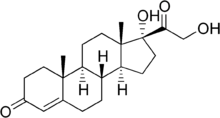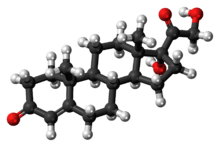Cortodoxone
 | |
 | |
| Names | |
|---|---|
| IUPAC name
(8R,9S,10R,13S,14S,17R)-17-hydroxy-17-(2-hydroxyacetyl)-10,13-dimethyl-2,6,7,8,9,11,12,14,15,16-decahydro-1H-cyclopenta[a]phenanthren-3-one | |
| Other names
11-Deoxycortisol; Cortoxelone; 17,21-Dihydroxypregn-4-ene-3,20-dione; 17,21-Dihydroxyprogesterone; 11-Desoxycortisol; 11-Deoxyhydrocortisone; 11-Desoxyhydrocortisone; Reichstein's Substance S; Compound S | |
| Identifiers | |
| 152-58-9 | |
| ChEBI | CHEBI:28324 |
| ChEMBL | ChEMBL253144 |
| ChemSpider | 389582 |
| 5100 | |
| Jmol interactive 3D | Image |
| KEGG | D03595 |
| PubChem | 440707 |
| UNII | WDT5SLP0HQ |
| |
| |
| Properties | |
| C21H30O4 | |
| Molar mass | 346.47 g·mol−1 |
| Melting point | 215 °C (419 °F; 488 K) |
| Except where otherwise noted, data are given for materials in their standard state (at 25 °C [77 °F], 100 kPa). | |
| | |
| Infobox references | |
11-Deoxycortisol, also known as cortodoxone (INN, USAN, BAN), as well as 17-hydroxy-11-deoxycorticosterone, 17α,21-dihydroxyprogesterone, and cortexolone,[1] is a glucocorticoid steroid hormone that can be oxygenated to cortisol (hydrocortisone). It was first synthesized by Tadeusz Reichstein, and has also been referred to as Reichstein's Substance.[1]
On April 5, 1952, biochemist Durey Peterson and microbiologist Herbert Murray at Upjohn published the first report of a breakthrough fermentation process for the microbial 11α-oxygenation of steroids (e.g. progesterone) in a single step by common molds of the order Mucorales.[2]
11α-oxygenation of cortodoxone produces 11α-hydrocortisone, which can be chemically oxidized to cortisone, or converted by further chemical steps to cortisol.
Subsequent fermentation processes for the microbial 11β-oxygenation of steroids in a single step were developed that could convert cortodoxone directly to cortisol.
Cortodoxone functions as a glucocorticoid, though is less potent than cortisol. It can be synthesized from 17-hydroxyprogesterone. In 11β-hydroxylase deficiency, cortodoxone levels increase dramatically, causing hypertension (as opposed to 21α-hydroxylase deficiency, in which patients have low blood pressure from a lack of mineralocorticoids).
Cortodoxone can also be converted to androstenedione.[3] This could explain, at least in part, the marked increase in androstenedione levels in 11β-hydroxylase deficiency.[3]
See also
References
- 1 2 R.A. Hill; H.L.J. Makin; D.N. Kirk; G.M. Murphy (23 May 1991). Dictionary of Steroids. CRC Press. pp. 338–. ISBN 978-0-412-27060-4.
- ↑ Peterson DH, Murray, HC (1952). "Microbiological oxygenation of steroids at carbon 11". J Am Chem Soc 74 (7): 1871–2. doi:10.1021/ja01127a531.
- 1 2 Auzéby A, Bogdan A, Touitou Y (January 1991). "Evidence for a new biologic pathway of androstenedione synthesis from 11-deoxycortisol". Steroids 56 (1): 33–6. doi:10.1016/0039-128X(91)90112-9. PMID 2028480.
| ||||||||||||||||||||||||||||||||||||||
| ||||||||||||||||||||||||||||||||||